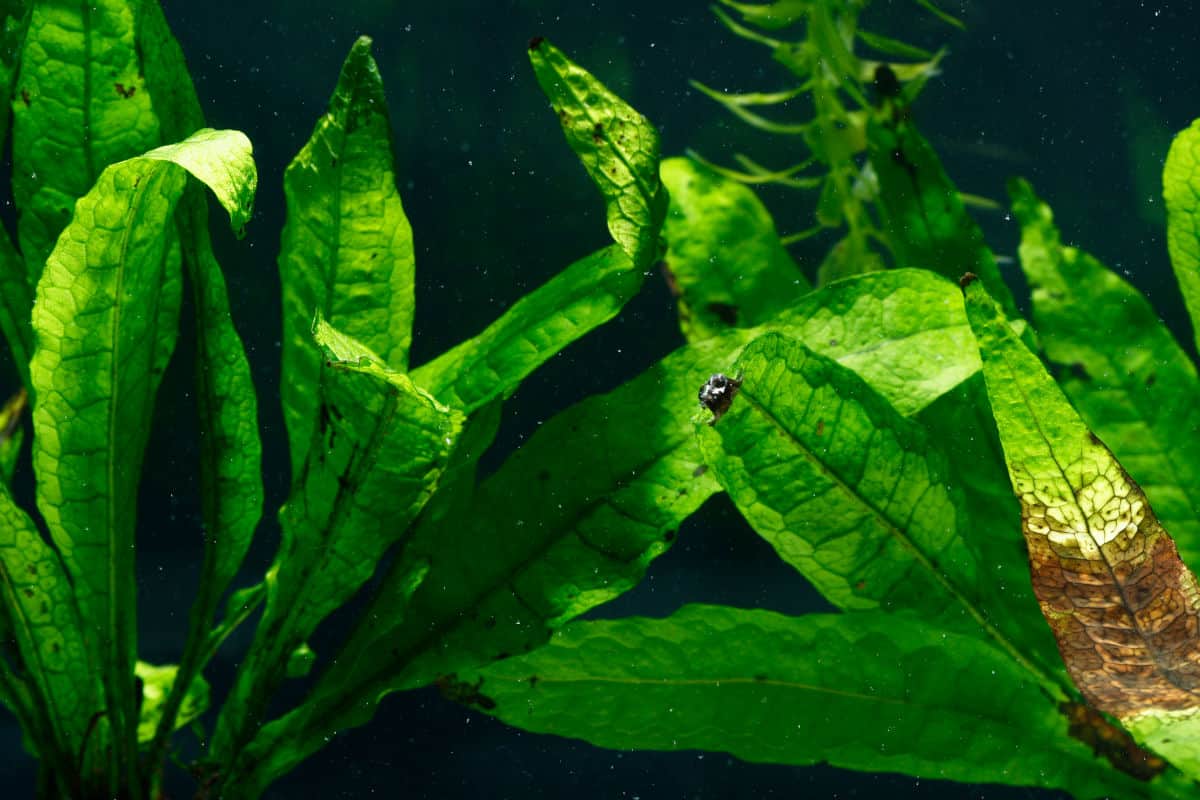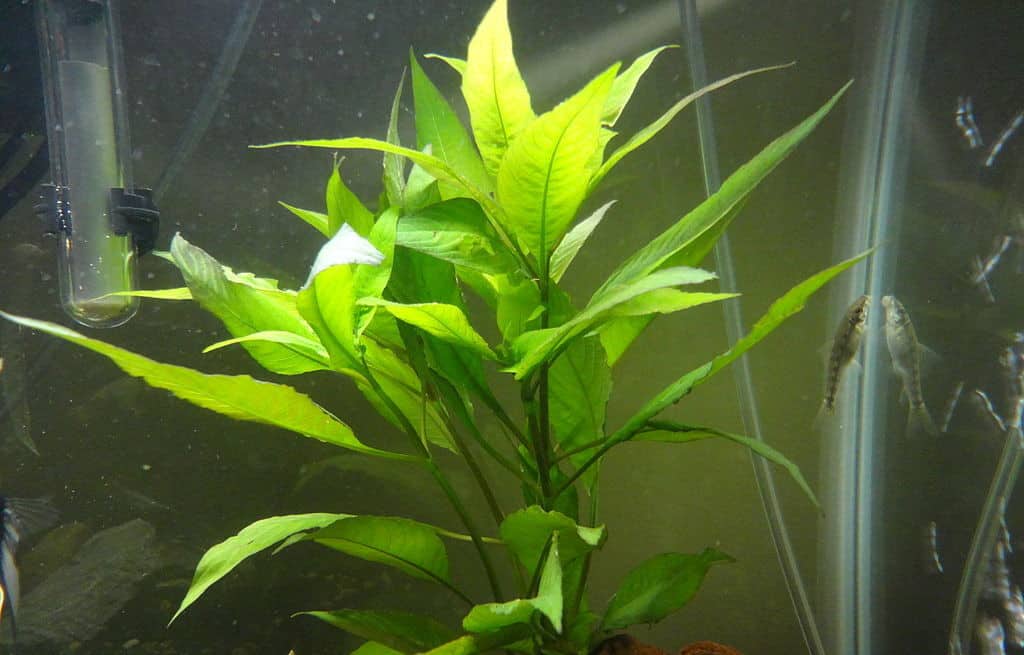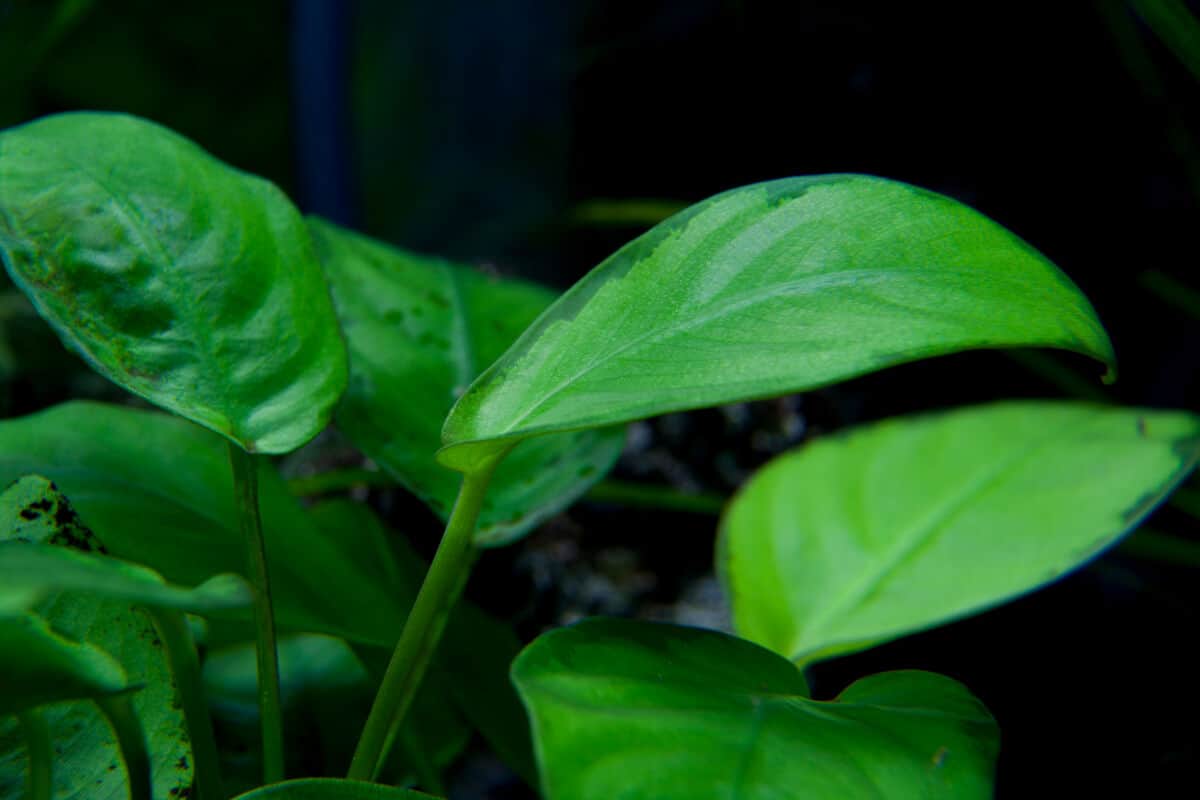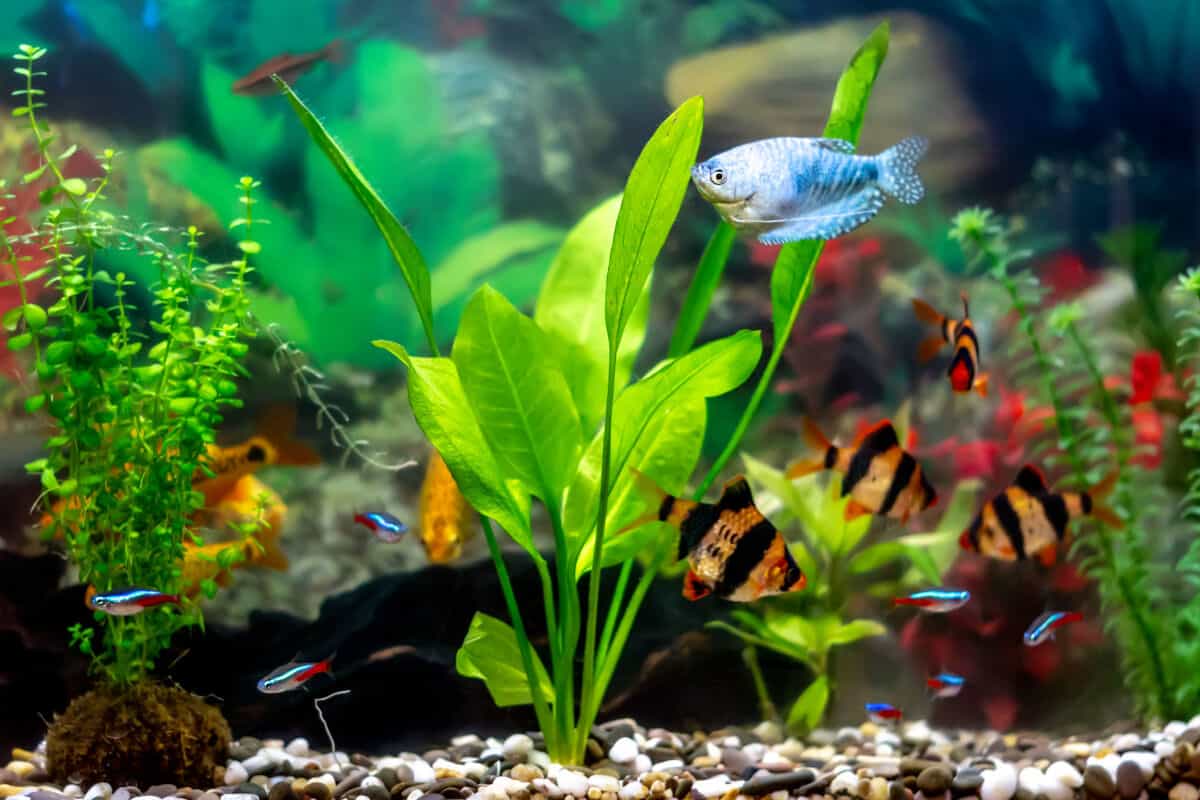An attractive-looking aquarium plant, java fern is popular among beginner aquarium hobbyists, likely due to its relatively easy care process. Originally from Southeast Asia, it usually grows on rocks or around tree trunks.
It grows slowly and doesn’t require strict parameters. It can be planted anywhere in the aquarium including directly in the gravel—although not completely buried in it, as we’ll speak more on later.
It can be cultivated in tap water in a wide range of lighting conditions and without any necessary additions of fertilizers or carbon dioxide. It thrives in high fish loads and is snail resistant.
Due to these factors and the ease of java fern care, it’s an excellent choice for improving the aesthetic of almost any aquarium without any high-maintenance hassle.
In terms of upkeep, java fern is considered one of the simplest aquarium plants to keep and made our list of best aquarium plants for beginners, but that doesn’t mean it will grow and thrive without any thought towards it health and upkeep.
In this guide, we discuss everything you need to know when choosing this live plant; How to find and buy healthy specimens, tank setup, planting, propagation and everything concerning caring for java fern.
Overview and Statistics
Also referred to as Microsorum pteropus, java fern will spread like a weed in good conditions and can reach over a foot in height and 6 inches in width.
| Characteristic | Details |
|---|---|
| Common name(s): | Java Fern |
| Scientific Name(s): | Microsorum pteropus |
| Family: | Polypodiaceae |
| Origin: | Southeast Asia (particularly China, Malaysia, and Vietnam); also, farm raised in the USA. |
| Color Form: | Green hues |
| Maximum Size: | 13.5 inches |
| Growth Rate: | Slow to moderate |
| Care Level: | Easy |
| Water Conditions: | Freshwater, 68 to 82 degrees Fahrenheit, pH 6.0–7.5, KH 3–8 |
| Lighting: | Low to moderate |
| Minimum Tank Size: | 10 gallons |
| Supplements: | High-quality aquarium fertilizer |
| Placement: | Mid-ground |
| Propagation: | Rhizome division, adventitious plants |
| Tank mates / Compatibility: | It’s incompatible with goldfish, who usually eat it. However, most other fish won’t bother with it. |
A perennial jungle plant, it hails from Southeast Asia. It usually grows on rocks, in the ground, on tree trucks near streams and waterfalls, or in the grass in tropical rainforests.
It grows both partially and fully submerged, and is said to be particularly prevalent in Thailand, Taiwan, Malaysia, and parts of China.
Identifying Java Fern
It anchors its dark brown, hairlike roots, which attach to wood, gravel, and rocks. It may even stick to entirely smooth stones since the plant is malleable enough to attach to so many surfaces. Often, the roots get sticky, and they can become quite long when they are not attached, as they grow in search of an anchor.
At the heart of java fern is the rhizome, which lengthens and thickens over time, to eventually cover wider areas. It might take months or even years for it to grow significantly.
The leaf structure comprises of potent dark green leaves with a hardened texture, and each can be up to 10 inches long by 1.5 inches wide. The plant itself grows to up to 13.5 inches in height and 6 to 8 inches in width, and all its leaves can develop as standalone plants separate from the mother plant. It’s categorized as a small aquatic plant.
Nodes might also be apparent, for the purpose of photosynthesis. Sometimes, there may be black bumps on the plant, which is entirely normal. The black spots are its sporangia—the reproductive organs. Don’t worry about your java fern care routine if you notice these, it’s a natural and expected part of the live plant’s growth.
Placement in a Tank
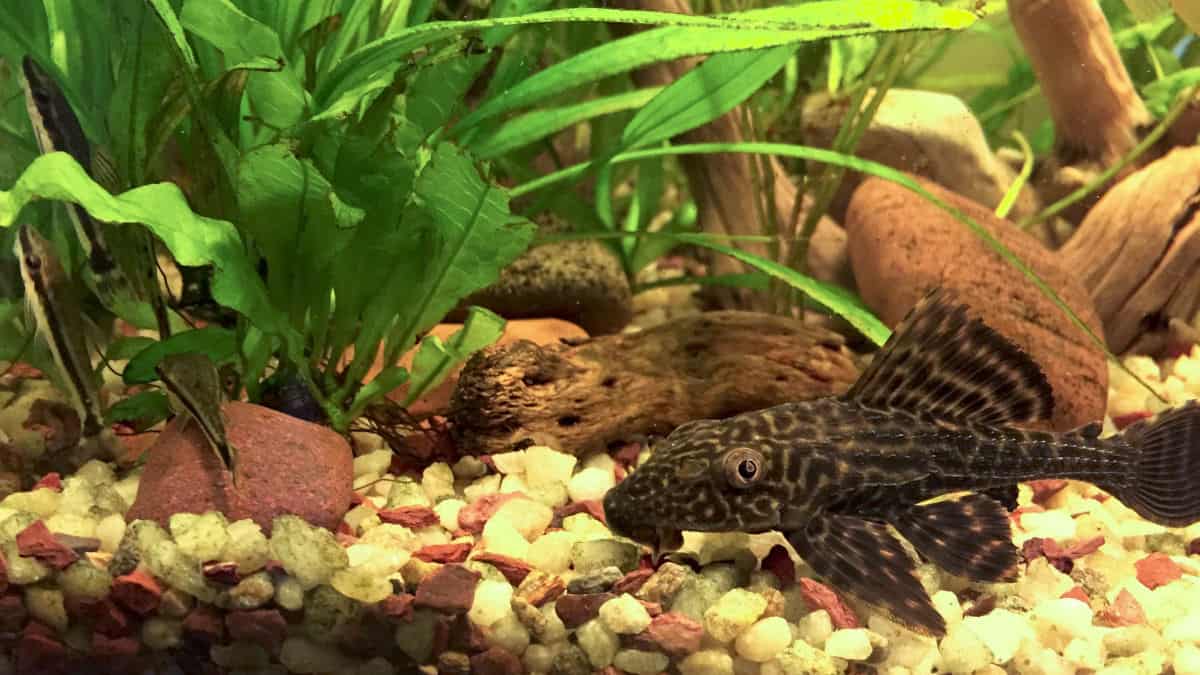
Because it’s quite tall, it’s best placed in the middle through to the background of the tank, as opposed to in the foreground, where it would block your view of the rest of the tank.
It shouldn’t be planted entirely in the gravel, which could cause the roots to rot and lead to poor health, or possibly destroy it entirely.
The roots are often attached to driftwood or rocks, as opposed to planted in the substrate. It can even grow in a partially submerged setting with the leaves growing up above the water surface, as long as there is some provision for humidity, such as a misting system.
Benefits Java Fern Can Bring to Your Aquarium
One of the prime benefits is it creates hideouts for smaller fish as well as those breeding. For example, duskies spend most of their time in hiding under java ferns in tanks.
Another benefit is the ‘natural look’ it can bring to your tank. Plastic plants have their place, but if you’re looking to recreate a gorgeous slice of nature in your home, live aquatic plants are the way to go, and java fern is a beautiful and easy to keep real plant.
Third, it helps to remove CO2 from the water, replenishes oxygen back into the wat for your fish, and uses up nutrients from the water that would otherwise go toward algae growth. It’s not a fast grower, so doesn’t suck up all nutrients, but it does help to some degree.
Also, compared to some other plants, very few fish types seem interested in gnawing at it, even those that might usually eat other aquarium plants. So java fern is a good choice of plant if your aquarium has plant nibblers. However, goldfish – the one fish demolition team with an appetite like a goat – will still eat it! They’ll eat anything.
It’s a firm, robust plant that will not only add a lush appearance to your aquarium, but can also thrive with relatively little nutrients, not much light, and a low level of upkeep. It also has great reproductive flexibility in the aquarium.
Tank Requirements/Preferred Habitat
It isn’t very demanding when it comes to tank setup and needs from it’s environment. But there are of course optimal conditions that you should try to aim for. Let’s take a look at those now.
Minimum Size Tank Required
The tank size can be as small as 10 gallons, but this really should be the minimum. Any smaller wouldn’t give it enough space to grow, and the plant would then take too much space away from any fish.
Water Type and Parameters
Since optimal water circulation is best for healthy growth, it’s recommended to have a filtration system that generates at least mild currents in your tank, or to have an airstone so that the rising bubbles circulate the water.
It’s also good to aim for a 10 to 25 percent aquarium water change on a bi-weekly basis. This is to prevent the buildup of excess nutrients or waste.
The ideal water conditions are a temperature between 68 and 82 degrees Fahrenheit, and the water quality should have a pH of 6.0 to 8.0 and a KH of 3 to 8.
Freshwater is preferred, but it can endure salt as well. Avoid brackish waters though, which could hinder plant growth and even lead to its death. Water salinity of up to 1.009 is acceptable.
Lighting Requirements
When it comes to light conditions, 1.5 watts of light per gallon is recommended, with 5000 to 7000k bulbs. Intense light may burn the leaves, causing brown or transparent spotting. It’s best to reduce brightness by using small fluorescent bulbs, or these days LEDs.
Generally, keeping your aquarium in low light is preferred. Any damage to the plant by strong lighting can be salvaged by reducing or turning off the lighting for a few days. Ideally, these conditions will facilitate its expansion to a fan shape, which eases the growth of new plantlets.
Substrate Requirements
It has no specific requirements in terms of the substrate since it doesn’t take up nutrients from the substrate itself, but from what’s in the water.
It does prefer a substrate, as it needs to anchor itself to something, though it can happily anchor to rocks, driftwood or other decorations if you prefer a bare bottom tank.
Growth Rate
The growth rate is slow, don’t expect to see any noticeable difference for at least a few weeks after planting.
It can reach up to 13.5 inches in height and 6 inches in width when fully mature but will take quite some time to get there.
The benefit to this is you won’t have to worry about constant and regular pruning and trimming. It’s very low maintenance.
It can be planted singly as well as in groups. So if you want your java fern to ‘fill a space,’ it’s best to buy a good number and plant it in bunches.
Care Tips
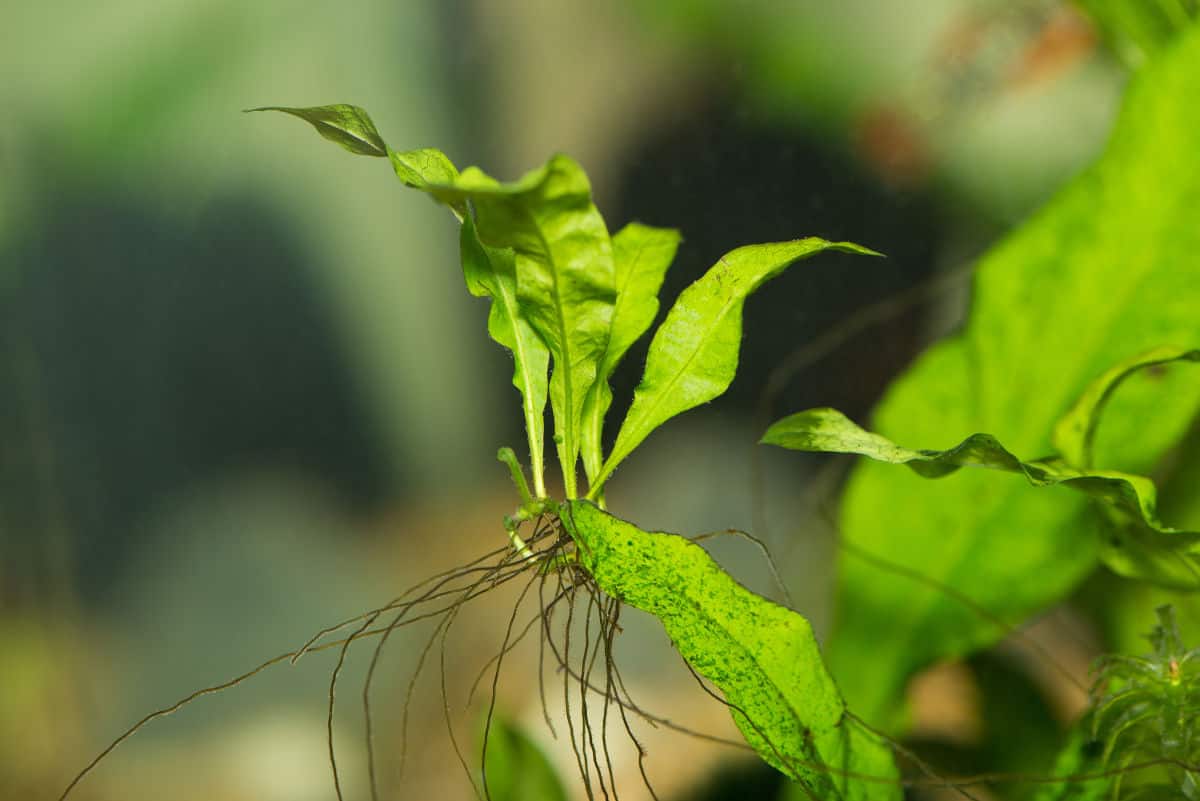
As previously mentioned, java fern care is relatively low maintenance. As long as the water parameters are within the recommended range, it doesn’t require any special supplements, and rarely if ever needs pruning.
Just be sure to look out for any dying leaves—they should be trimmed in order to make way for new, healthy rhizome and leaf growth.
Purchasing Advice
It is a relatively cheap plant, costing as little as $4 to $5, or up to $20 for plants pre-acnhored and growing on wood. It’s available in most pet stores, aquarium stores, and online vendors in numerous varieties, including narrow leaf, needle leaf, windelov, lance leaf, and more.
You can order them online from almost anywhere in the world since its sturdy build means it can survive transit pretty well.
Upon purchasing, make sure there’s no brown edging and that your selections are green and healthy looking.
How to Plant It
As a relatively low-maintenance plant, the only major thing you need to keep in mind when planting java fern is not to bury it in the substrate, since it takes its nutrients from the water through its roots. It should be healthy as long as it’s tied to a rock or driftwood.
The most important thing is that the rhizome is exposed to the water column.
Java fern will die if it’s planted too deeply in the substrate. While it might take some time to stabilize in the aquarium, that’s completely natural.
Tank Mates/Compatability
Most fish don’t seem to bother it—probably because its stiff structure makes it unattractive to eat for almost all fish types. This is true of both smaller and larger fish, including cichlids, tiger Oscars, catfish, and others that are usually incompatible with more thin-skinned plant species.
South American fish, in general, are a great match as well. It’s known to thrive with tropical fish particularly, as their ideal water parameters most closely match.
While java fern might be a great choice to go with most herbivore species in the tank, it isn’t an optimal choice for a goldfish tank as they are known to eat it. Generally, avoid housing it with larger or more forceful fish, and if you do, ensure that the plant is adequately attached to rocks or driftwood.
Propagation and Reproduction
It is a self-propagating plant through an adventitious process. Similar to other aquarium plants, it reproduces asexually as it forms old leaves that break off from the rhizome separately from the mother plant.
At the ends of the java fern, dark bumps develop, before turning into young plantlets that eventually fall of the leaf and develop into standalone plants. As this happens, new rhizomes are formed and the process repeats itself.
Over time, the rhizome magnifies and the plant’s size, as well as the number of actively reproducing leaves, increases. In time, this creates an abundance of young plants, which break off the mother leaf once they reach about an inch in size.
It may take a few weeks for the new standalone plant to grow. Within two to three weeks, tiny leaves may emerge from the black bumps developing from the mother plant’s underside. It’s best to bind the new plants using a rock or piece of driftwood.
Another process for propagation is rhizome division, which involves your input to separate new growth from the rhizome of the main plant. This requires partly cutting the rhizome using sharp scissors before replanting the new sections, which will allow separate plants to begin growing.
You can see an example of this process in the following video:
Summary
As a versatile, low-maintenance plant, suitable for almost any level fish keeper or aquarist, it has been said that the only way not to keep java fern healthy is to actively want to kill it.
By making sure your tank is at least 10 gallons with dim enough lighting and keeping any goldfish away from it, you’re bound to have a lush, happy java fern.
Let us know in the comments section how easy you found java fern care to be, or if you’ve any tips and experiences you’d like to share? And if you need any guidance, we’re here to help so please do ask any questions in the comments below.

